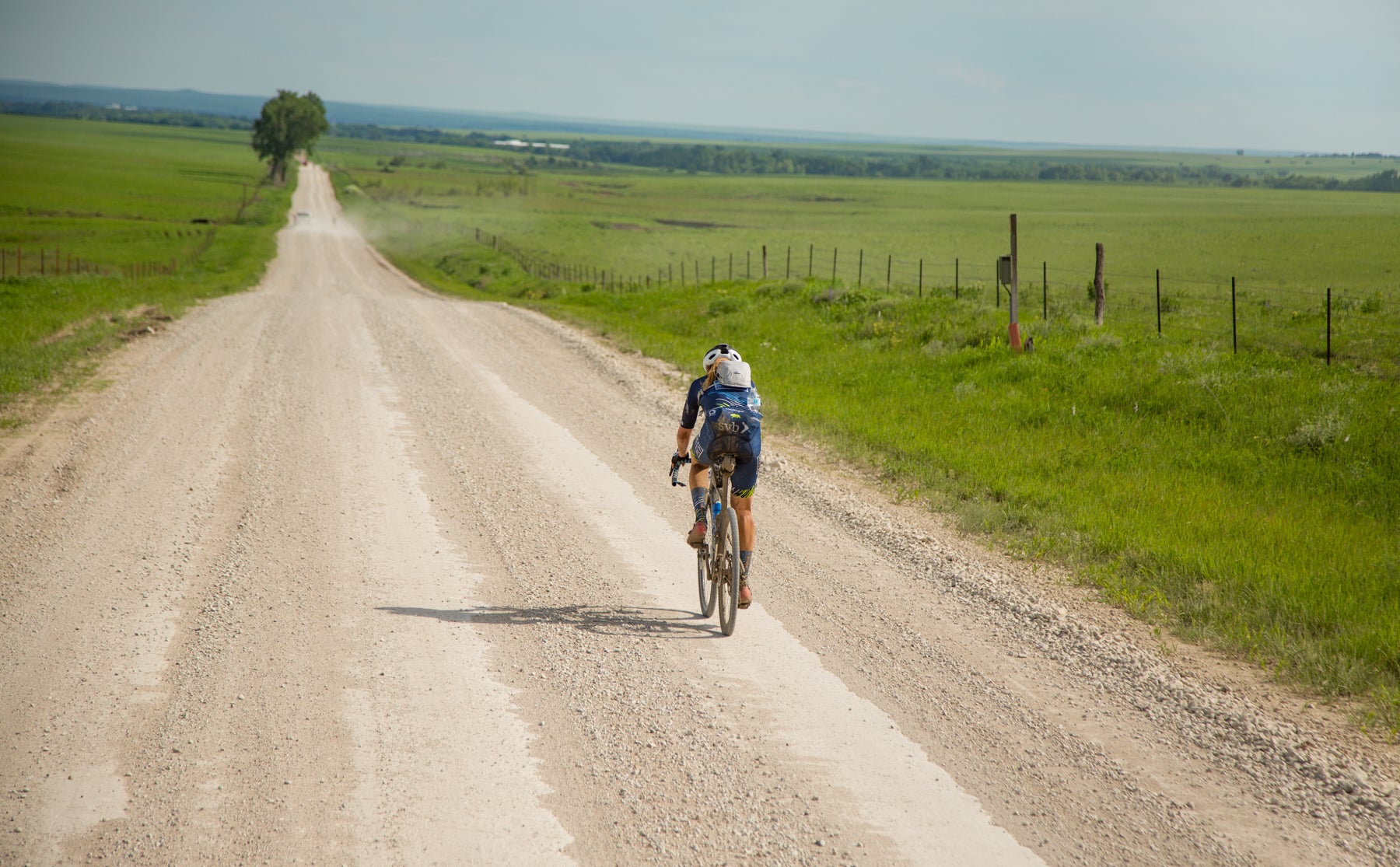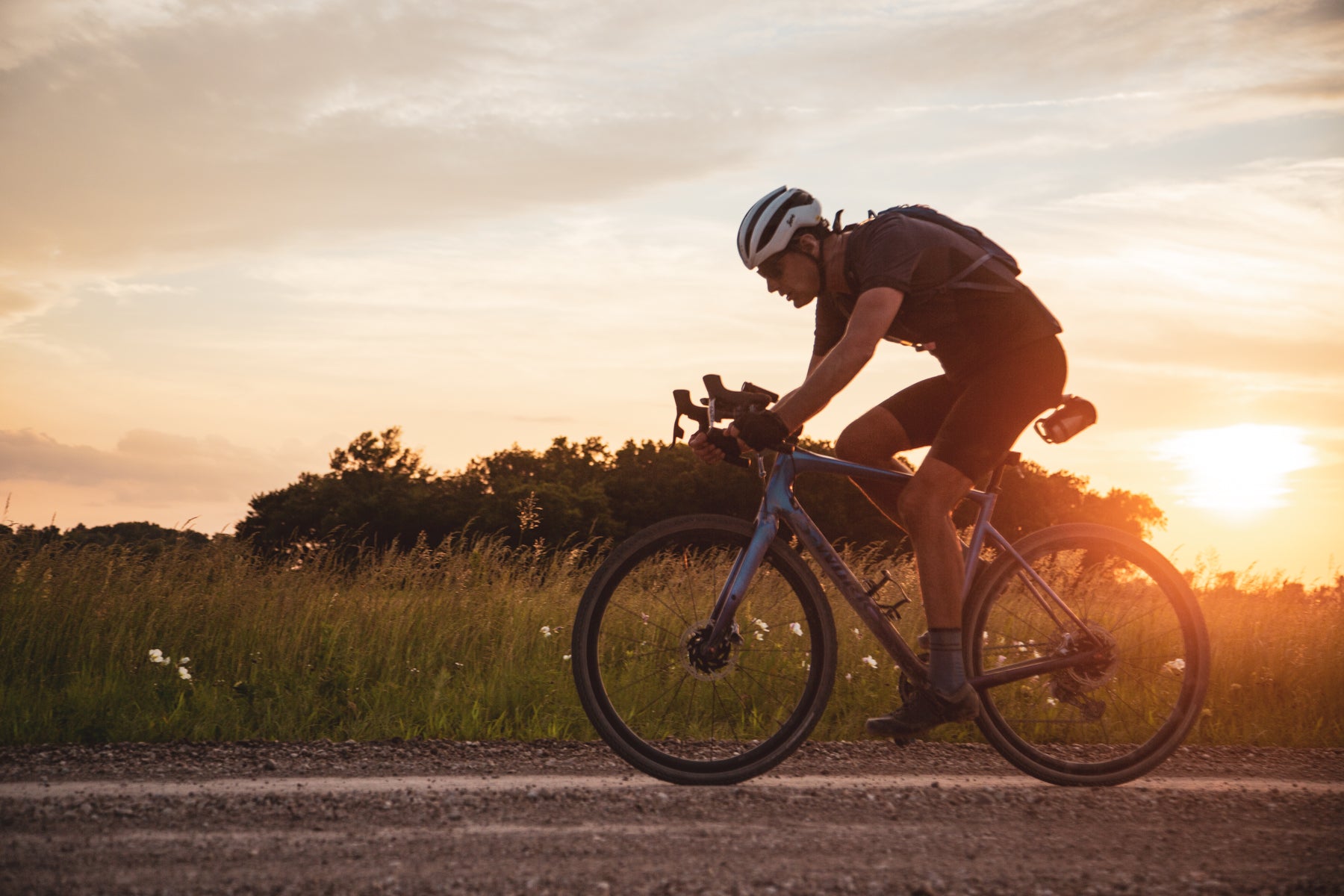You don't need to be miserable during training to be happy during races.
I like targeting big hairy audacious cycling goals — tough bucket-list endurance races like Unbound Gravel 200, SBT GRVL, or Leadville MTB 100. These types of events are HARD, which means it's a good idea to train for them. But with a needy toddler, a full-time job, and a million other commitments, my life is super busy and stressful. Every time I try to stick to a training plan, I eventually fall off the wagon, which creates immense feelings of guilt and anxiety.
A couple years ago though, I finally found an "easy" training strategy that works well for me. I now approach training for big events in a simpler and more relaxed way. This has reduced my stress, improved my fitness, and it even helped me achieve success at many of my biggest races. I think it’s a great way to approach training for anyone new to endurance events or who can't commit to a tough or complicated training plan.
[button]Shop Bikes[/button]
To Get Fitter and Faster, Consistency is King
Consistency is one of the most important factors when it comes to performance.
When a reporter asked the great Eddy Merckx what advice he would give to aspiring riders, Merckx just replied, “Ride lots.” It sounds simple, and it is. To improve at riding your bike, you just need to ride your bike more.
Of course, there is more nuance to it. If you ride too much or too hard, you’ll dig yourself into a fatigue hole or end up with an injury that will be difficult to recover from. And who has time for that anyway?
For regular people with busy lives, “ride lots” basically means achieving a decent level of consistency. What exactly does that mean? Let’s consider this hypothetical situation: you only have 5 hours a week to ride your bike. Is it better to do five 1-hour rides throughout the week, or a single 5-hour ride once a week?
According to all the coaches I know and work with, the answer is five 1-hour rides. Even if you’re not doing longer rides, you’ll still improve your endurance and get fitter because you’re riding on a more regular basis. The key to success is slowly and consistently building your riding volume.
 Photo: Lifetime
Photo: Lifetime
Ride 4-5 times each week, every week. No matter how long you have to ride each day, riding consistently will net you improvement.
You may have heard of the concept of “greasing the groove,” a training technique coined by Pavel Tsatsouline, a former Soviet trainer. Greasing the groove essentially means not working your muscles to the point of failure so you can work them more often.
For example, if you want to do more pull-ups, you do a few reps at a time, throughout the day, every day. This way, you’re never working yourself to exhaustion, so you recover faster, while building a large amount of training volume over time. (Not cycling related, but by consistently doing sets of 4-5 pull-ups throughout the day, I actually worked up to doing 20 at once.)
I’ve since applied this concept to my riding. I ride a lot, but I don't destroy myself during my rides. Since most of my rides are easy, I can ride more often, generally 5-6 rides per week, for many weeks in a row. This sort of riding volume is what I mean by consistency.
“Consistency is one of the most important factors when it comes to performance,” explained Coach Johann Van Zyl, a former World Tour pro and coach for Catalyst Coaching. “There’s no point in training hard for a week, then doing nothing the next, then getting back on the trainer the week after, etc. Consistency is key. You’ll be better off averaging 5 hours a week, consistently, than having these big spikes and gaps in your training.”
Coach Frank Overton of FasCat Coaching said the same. “Rome was not built in a day and, similarly, neither will your fitness,” he said. “Ride 4-5 times each week, every week. No matter how long you have to ride each day, riding consistently will net you improvement. Honestly, 1 hour a day, 5 times per week is a great place to start. That's 5 hours per week and then you can layer more time onto those 5 days to improve even more. Riding 5 hours on Saturday but no hours during the week is like being the hare, and the tortoise (riding 1 hour a day 5 times per week) beats the hare every time.”
I've tried following tougher training plans that incorporated a lot of intervals and threshold or sweetspot efforts. In the end, these programs always added a huge amount of stress to my life. They would sap some of the joy out of cycling, until eventually, I’d start missing workouts and quit. I’ve gone through this cycle countless times.
Last year, instead of going through it again, I retooled my training to make consistency the primary goal. The only thing I focused on was riding regularly every week and slowly increasing my riding volume. This kept riding fun and made it easier to fit more rides into my busy schedule.
My “Easy” Training Plan for Cycling
 Photo: Lifetime
Photo: Lifetime
1. Do 3-6 rides (30-90 minutes) per week
2. Do a "long" ride (3-8 hours) every 1-3 weeks
If this seems simple, it’s because it is. That’s the point. The simpler the plan, the easier it will be to stick to. This is what helps me stay consistent.
There's a lot of flexibility too. The number of rides per week and the time on the bike can be tweaked accommodate your fitness level, schedule, and life circumstances. You don’t have to stress about anything besides riding regularly.
To prepare for a 200-mile event like Unbound Gravel, I try to ride my bike 4-5 days a week. I do both indoor and outdoor rides and fit them in whenever I can — early morning, lunch, or after my kid goes to bed. The vast majority of my rides are done at an easy pace and are only about an hour long. My Sundays are generally reserved for a longer (4+ hour) endurance ride. I personally don't do more than one long ride per week.
If your goal is to complete long-distance events that are 100 miles or more, I consider 3 rides per week the bare minimum. Both Coach Johann and Coach Frank said that 5 one-hour rides per week is a good starting point for moderately fit cyclists, and that’s where I started as well. Experiment with what works for you, and if you start to feel too fatigued, back it off and rest. If you feel good, try adding more work.
When training for long-distance events, it’s a good idea to incorporate occasional long rides into your routine too. This will familiarize your body with the effort and boost your confidence. While it can sometimes be a good idea, you don’t necessarily need to do the full race distance in training. For super long events, it usually not even practical.
As a general rule, most riders will be able to go around 50% longer than their longest training ride. For Unbound (200 miles), I didn’t do any training ride longer than 8 hours.
[newsletter]
More Endurance Training Tips
Here are a couple more important tips to consider before diving into any endurance training…
1. Think in hours rather than miles
Not all mileage is the same. Elevation gain, terrain, weather conditions, fitness, and equipment will all affect the “value” of a mile. An hour of pedaling, however, is much a more consistent measurement. For building and tracking your riding volume, it’s much more useful. Many experienced racers think in hours, and they measure their workload in training hours per week. For me, thinking in hours reduces stress too because I don’t get hung up on distance.
If I'm trying to increase volume and build fitness for my target events, I just focus on increasing my time on the bike per week. In the 8-10 weeks before the event, I'll slowly increase my weekly time on the bike by about 30-60 minutes each week, either by adding more rides or lengthening rides.
2. Incorporating intensity
Intensity (i.e., riding hard — above threshold to VO2 max pace) is good for you. But in the name of training, it's easy for motivated cyclists to get overzealous and end up doing too much.
“In a world where we're time-crunched and searching for the best ‘bang for our buck,’ we often make the mistake of riding too hard too often,” Coach Johann said. “While following a high-intensity program will quickly raise your performance to an acceptable level, you’ll plateau and won’t be able to hold that shape very long. Incorporate more low-intensity workouts into your training to help build your aerobic foundation, ultimately allowing you to reach a higher level once you add intensity on top of that.”
Last year might be the first time I took that advice seriously. By doing the vast majority of my rides at an easier pace, I recovered faster, so I could ride more and stay more consistent. Remember, my goal is to grease the groove, not wreck my body. It also left me with more energy for my family, work, and other hobbies. If I felt good, I would ride hard, but I’d only do that once or twice a week at most.
3. Fuel the work
I've always struggled with eating on the bike. In recent years, I made a point of always eating something during any ride longer than 45 minutes. Not only does this improve performance and recovery, but it also trains your gut to handle the amount of eating you’ll need to do during your goal race.
Again, I don’t do anything too complicated. I just eat something every 30-45 minutes. You can use bike-specific nutrition or simpler store-bought items. I like Rice Krispies, Pop-Tarts, and other treats like that.
It goes without saying that training is only part of the equation. Diet and recovery are equally important. To get the most out of your time on the bike, eat well and get enough sleep off the bike!
Final thoughts

RunRide a lot of miles,
Some faster than your race pace,
Rest, once in a while.
― Training haiku by Mayo Clinic physiologist Michael Joyner (edited for cyclists)
I call this training plan “easy” because it’s uncomplicated and extremely adaptable. Most of the rides are done at an easy pace too. As long as you’re regularly on the bike throughout the week, every week, you will get much fitter. But you still need to put in the work and actually ride. Remember, consistency is key.
Will following a super basic plan like this help you finish your next endurance race? Yes. Will it maximize your potential? Probably not. If you're an experienced rider who wants to dial in your performance and compete, then you’ll need something a bit more advanced that focuses on things like intervals, power zones, and other data. This is where cycling coaches or virtual training services like TrainerRoad can help take you to the next level.
For me though, a simple program like this works for me. It’s easier to manage, and it fits in better with my life. If your main goal is to finish a long-distance cycling event at the edge of your capabilities, and not feel miserable on the bike, then this will work for you too.
[button]Shop Bikes[/button]

























